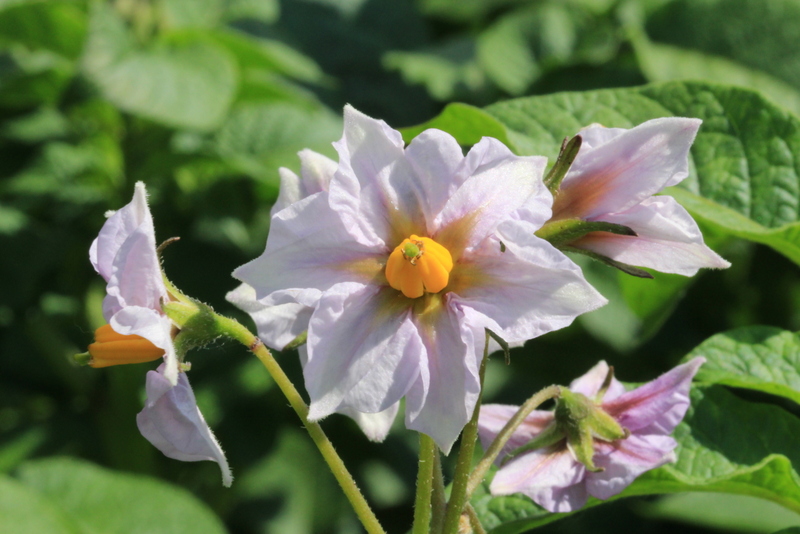Potato Extension
UNECE Guide to Seed Potato Diseases, Pests and Defects
A Booklet on potato pest and diseases from the United Nations Economic Commission of Europe (UNECE), Specialized Section on Potato Diseases is now available on the internet. This book has many nice pictures of potato diseases, pests, herbicide injury, and other potato defects.
Winter Test Results for North Dakota Seed
The North Dakota winter test results are now available. Certified seed is grown in Homestead, FL each year.
Unbelievable Success Stories of Weed Control in Potatoes: Linex + Metribuzin
My presentation at the Wild World of Weeds Workshop on linuron use in Russet Burbank potato. This research compared the tank mixture of linuron + metribuzin as a preemergence, 50% emergence, and postemergence weed control option and effect on plant growth and production. Application at 50% emergence had excellent weed control and generally the greatest marketable yield. Read and follow label directions for use of all herbicides.
Potato Scout School
The NDSU/U of M Potato Scout School will be held on February 19, 2015 from 12:30-4:00 pm at the Canad Inn in Grand Forks, ND. This event will provide training on potato diseases, insects, and weeds by the NDSU and University of Minnesota Potato Researchers and Extension Specialists. The focus of training will be to assist those who are new to the potato industry as well as help those who have been around for a while sharpen their skills in pest identification and crop management. Registration is required because seats are limited. There is no cost to this event because of generous sponsors.
Potato Expo Poster - Residual effects of Rejuvenate on potato seed for stem management
Research shows that stem number and tuber number are highly correlated. Physiologically old seed or varieties with many stems can have high tuber sets causing many undersized tubers. Altering the number of stems can be an effective way to control tuber set. Previous work demonstrated that 1-naphtheneacetic acid (NAA), Rejuvenate, treatments on seed can reduce stem number and increase tuber size and marketable yield. Grower practices vary greatly when treating seed. Some seed is fresh cut and planted without delay. Other seed is cut and stored for many weeks, allowing seed to suberize and providing flexibility for the planting schedule. In some cases, bad weather can delay planting. It is unknown what the effects of seed treated with NAA in storage has on stem number.
Sanitation for Bacterial Ring Rot
This presentation will help consultants, growers, and other practitioners in potato producing areas throughout the U.S. implement proper sanitation and disinfectant procedures for bacterial ring rot, a zero tolerance disease in the seed potato industry. Periodic outbreaks of this disease require vigilant testing and sanitation to prevent and manage additional spread and infection. This presentation explains how the Cms bacteria survive, proper disinfection procedures to prevent ring rot, suggestions for cleaning facilities and equipment if you have ring rot, and characteristics of frequently used disinfectants. By the end of this presentation, practitioners and potato growers should understand proper sanitation and disinfection procedures to reduce the risk of bacterial ring rot in potato operations and farms.
Internal Physiological Disorders: Internal Heat Necrosis and Blackheart
Internal physiological disorders reduce the quality and marketability of potatoes. They are not caused by pathogens, rather physiological typically caused by the environmental conditions. Every few years, a plethora of potatoes exhibit internal heat necrosis and blackheart in the Red River Valley. This Extension bulletin discusses management strategies and show what the results of these physiological internal disorder can look like.
Update on Potato Sprout Control
A new Focus on Potato: Update on Potato Sprout Control by Dr. Nora Olsen, University of Idaho. This presentation will update growers and industry personnel in the US on potato sprout control options. Specifically, advances in technology, development of new products and formulations, and coordination of control programs have allowed flexibility and fine-tuning of sprout control in the industry. Variety differences, storage management practices, and consumer expectations have necessitated an integration of ways to minimize sprout development in storage, through the cold chain, and/or in retail displays. General background and specific program options will be discussed. Information provided will help in the development of an individualized integrated program based upon variety, storage conditions, and market.
NFPT 2014 Clone Pictures
Pictures of the potato clones from the National Fry Processing Trial held in East Grand Forks, MN. The purpose of the national variety trial program is to identifying new potato clones suitable for french fry processing. The varieties are from breeding programs throughout the United States and they were grown in Washington, Idaho, North Dakota, Wisconsin, Michigan, and Maine this past year.
The Contributions of Pesticides to Pest Management in Meeting the Global Need for Food Production by 2050
A new paper that considers the growing population and how pesticides can help meet the need for food production by 2050. Along with better pest management, pesticides have led to the development of improved agronomic practices such as no till, conservation tillage, higher plant densities, increased yields, and the efficient use of water and nutrients. When applied in safe, smart ways, pesticides lead to more sustainable agriculture. The authors cite many statistics and specific examples. They point out that more than 800 million people in the world are food insecure today and that the amount of crop yield lost yearly to pests can run upwards of 30%. But they are optimistic about developments occurring around the globe to minimize this loss. When pesticides are effectively applied and fully integrated into a comprehensive approach, the world will be on its way to providing sustenance for the 9 billion humans on earth in 2050.
Document Actions





